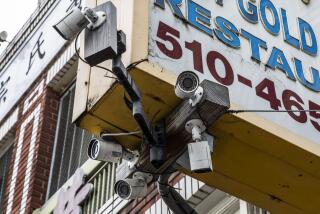Delay Mounts for FBI Fingerprint System
- Share via
WASHINGTON — A computer system that would allow police officers to check a suspect’s fingerprints from their patrol cars--a cornerstone in the FBI’s ambitious effort to tap new technology to fight crime--has fallen four years behind its development schedule and more than doubled in cost, according to new estimates that will be made public today.
The system, known as the National Criminal Information Center 2000 (commonly called NCIC 2000), is supposed to represent one of the biggest advances in police technology in two decades.
The new cost estimates, along with updates about the FBI’s efforts to fix the system’s technical glitches, will be disclosed today to an advisory panel of federal judges, local police officials and prosecutors meeting in San Diego.
“There is room for criticism that this has been delayed and didn’t get done when it was supposed to,” said Deputy Assistant FBI Director Harlin McEwen. “But do we have it under control and on track today? Yes.”
The FBI’s latest cost estimate for the system is $183.2 million, more than double the original $73 million when the program began in 1993, McEwen said. Originally, the FBI had planned to have the system available to police in March 1995. But the system’s current completion target date is July 1999, he said.
The program has been falling behind schedule ever since the FBI awarded the contract for the system to Harris Corp. of Melbourne, Fla.
Industry critics said that part of the problem is an ambitious FBI development schedule and numerous changes in the system’s requirements. But the critics said that Harris had exacerbated the problems, mismanaging both the software and hardware requirements at the outset.
Another complication is that Harris purchased an Amdalh Corp. computer to operate the system that lacked the necessary computing capacity. The FBI has since contracted with IBM Corp. for a more powerful computer.
When Harris began the project, McEwen said, the officials at the firm “didn’t know what it was building and didn’t understand the requirements. Worse yet, they didn’t tell us that they didn’t understand.”
Harris officials declined comment. Harris originally was supposed to develop the system for under $47 million and is now headed toward a cost of $144 million for its part of the program, McEwen said.
The FBI negotiated a major change this year to the Harris contract, the eighth time that the pact has been amended, and was forced this year to seek additional funding from Congress. The House and Senate appropriations committees forced the FBI to pay for the cost increases with funding from other programs in this fiscal year.
NCIC 2000 is supposed to update the FBI’s existing criminal information system, which was considered a revolution in law enforcement when it was introduced in 1967. The system handles about 1.7 million police queries every day.
But the system has been modified so many times since then that it is “covered with Band-Aids” and badly in need of a major modernization, according to a senior law enforcement expert in technology.
Among other things, the new system is intended to enable local police to receive electronic mug shots of suspects in their patrol cars, to check a suspect’s fingerprint against a database of wanted individuals and to check databases of convicted felons.
Local police have been clamoring for the capabilities of the new system, seeing the potential to vastly increase their productivity and reduce the number of false arrests. In some cases, local and state police have invested heavily in hardware for NCIC 2000.
The fingerprint capability would enable police to determine whether an individual is one of the roughly 400,000 wanted persons loose on the streets. If a fingerprint check in the car confirms that a person is wanted, the police then can take the person into custody and perform a more thorough, 10-digit fingerprint check at the police station.
Although the fingerprint capability has received a lot of attention, police officials said that other features of the system are just as important, particularly the ability to transmit digital mug shots to police cruisers.







